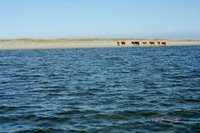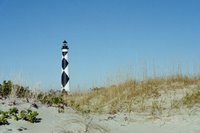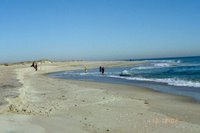

 Yesterday my Dad, brother, and I went out of Harkers Island to do some fishing around Cape Lookout. Here’s a glimpse of the trip.
Yesterday my Dad, brother, and I went out of Harkers Island to do some fishing around Cape Lookout. Here’s a glimpse of the trip.Coming back in from the north, we passed the Cape Lookout Lighthouse and the old Coast Guard Station, running parallel to the beach. Dad's at the helm, my brother and I each standing to the side of the console, holding on and leaning forward. The water is unusually glassy this morning, but that changes at the Cape Point. When we crested the first wave and dropped into the trough, Dad turned the bow of the boat into the next wave and cut his speed, carefully taking each wave. The shallow banks extending from the cape, well off shore, create turmoil in the water. Five or six times we rise over the crest of the waves and slid down the backside, until the water returned glassy and we head east, toward the jetty, where we stop to try our luck plugging and jigging for trout. We pull the boat into an open section, between other boats, turned the bow seaward, and set a short anchor, to keep the boat from drifting into the rocks. From there, the three of us stand at the back of the boat and cast toward the rocks. Nothing is biting, at least on our side of the rocks. It appears we’re too late for sea trout, who moved when the water got too cold. Yet, we’re too early for stripper. Other boats, mostly those on the other side of the rocks, caught a few fish, but almost all were too small and released back into the water. We fished for an hour, taking turns to eat a lunch for a can—beanie weenies and sardines—before continuing inland, stopping by Shackleford Banks to hunt for shells, wild horses and the lost community of Diamond City which use to exist there. We found plenty of shells and saw a dozen or so horses, but never found the site of the community that died after a hurricane in the 1890s exposed its vulnerability and sent survivors scurrying back to the mainland.
History runs deeper than the shallow waters along the lower portion of the Outer Banks. Native Americans fished and collected oysters and clams from the backwater sound. Edward Teach, the feared pirate Blackbeard, used the many inlets to slip away from the British Navy as he plunder shipping along the southeast coast. His fate was sealed 30 miles or so north of here when his ship, the Queen Anne’s Revenge, ran aground fleeing the British. Afterwards, small fishing communities sprung up along these islands, its residents fighting the sea as they struggled to make a living and to survive the elements. In addition to fishing, they supplemented their income by salvaging from ships that had run aground in the numerous shoals that extend out into the water. Legend has it, some would build fires on the beach during stormy weather, to confuse captains into thinking it was a lighthouse and causing them to run aground. After saving the crew, they’d help themselves to the loot. Because of the treacherous nature of the coast, a small lighthouse at Lookout was replaced in 1859 with one that still towers 163 feet above the sand. The light from the brick structure can be seen 20 miles out into the ocean. In the Civil War, the North sought to quickly gain control of these islands as a base of operation for their blockades of southern ports. After the fall of Fort Macon, a masonry fort that guarded Beaufort (pronounced Boughford in North Carolina), they effectively control over half of North Carolina’s coastline. In early January 1865, a large flotilla of Union warships sought harbor at Morehead City and Beaufort as they waited out a raging nor’easter. A few weeks later, after the largest naval bombardment ever on American soil, they’d capture Fort Fisher and close off the port in Wilmington, the last port open to the Confederacy. Losing their vital supply line to Europe, the Confederate States malnourished army was doomed. Following the Civil War, the island’s residents continued their lonely existence under the watchful eye of the lighthouse. In the 1870s, the lighthouse received its daylight markings, painted black and white in diamonds, to distinguish it from the lights at Hatteras and Oregon Inlet. Today, all the people are gone from the communities on these islands, although their weathered buildings remain. The string of islands is a part of the Cape Lookout National Seashore.
Setting course toward the lighthouse, we run parallel to Shackleford Banks, going opposite of a herd of horses running along the shore. After the point, we turn hard to the northeast east and enter Barden Inlet. Hugging the red buoys, we snake our way through the channel through the brown marsh grass, into the back sound between Shackleford and the mainland, keeping a watch for the sifting sandbars. A dozen pelicans fly overhead. A seagull claims a perch on a buoy. When we get into the back sound, between Shackleford and the mainland, Dad opens the motor up. The wind is cold even though the December sun is bright, its rays shimmering along the water as we make our ways toward long leaf pines towering above Harkers Island.
Hi Sage!
ReplyDeleteI hope your holiday season is filled with much love and joy; may it be so!!
Bhakti
Days like those are the kind you want to remember... I hope it brings you happiness to look back on it in years to come.
ReplyDeleteHello, Michele sent me!
This sounds so beautiful, very vivid in description. It must be so nice to be "home" for the holidays and spend time with your family. Merry Christmas!
ReplyDeleteFascinating history here..! Thanks forthat and A Very Merry Christmas To You, Sage....
ReplyDeleteI'm here from Michele tonught...
Hope your Holidayis a very sweet one!
Merry Christmas Sage. ( Michelle didn't tell me to say that ;) Really enjoyed the history.
ReplyDeleteWhat beautiful writing! I love all the imagery. Happy holidays!
ReplyDeleteI love this miniature history lesson, and a remembrance of my adopted state. Thanks, and I hope you had a wonderful Christmas!
ReplyDelete